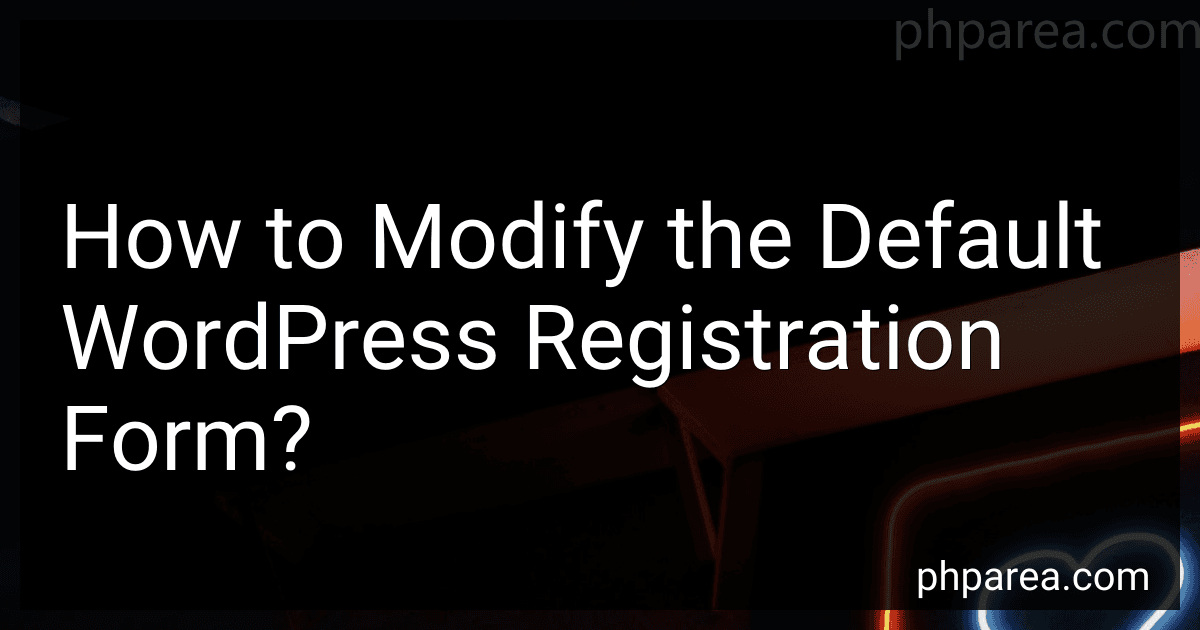Best WordPress Form Plugins to Buy in December 2025

How to Make Your Website Run Itself: WPSetup Attack Security & Near-Zero Admin with WordPress® Plugins



WordPress Masterbook 2020: Make a Website From Scratch For Total Beginners (Masterbook Series)



Does This Blogsite Make My Wallet Look Fat?: How to Use a WordPress Blogsite to Make Money, Attract Clients, and Gain Expert Celebrity Status



Double Your Publishing Sales (2016): How to do proper keyword research and do simple little tweaks to make more money in your publishing business


To modify the default WordPress registration form, you can follow these steps:
- Locate the "functions.php" file in your WordPress theme. This file is usually found in the theme's main directory.
- Open the "functions.php" file using a code editor.
- To remove or hide fields from the registration form, you can use the "register_form" action hook. For example, to remove the website URL field, you can add the following code:
function remove_website_field($fields) { if (isset($fields['website'])) { unset($fields['website']); } return $fields; } add_filter('register_form', 'remove_website_field');
- To add custom fields to the registration form, you can use the "register_form" action hook along with the "add_action" function. For example, to add a custom phone number field, you can add the following code:
function add_custom_fields() { ?> Phone Number <?php } add_action('register_form', 'add_custom_fields');
- To validate and save the custom fields on registration, you can use the "registration_errors" and "user_register" hooks respectively. For example, to validate and save the phone number field, you can add the following code:
function validate_phone_number($errors, $sanitized_user_login, $user_email) { if (empty($_POST['phone_number'])) { $errors->add('phone_number_error', __('Please provide a valid phone number.')); } return $errors; } add_filter('registration_errors', 'validate_phone_number', 10, 3);
function save_phone_number($user_id) { if (!empty($_POST['phone_number'])) { update_user_meta($user_id, 'phone_number', sanitize_text_field($_POST['phone_number'])); } } add_action('user_register', 'save_phone_number');
- Save the "functions.php" file and upload it back to your WordPress theme directory.
By following these steps, you can modify the default WordPress registration form by removing or adding custom fields according to your requirements.
How to enable email confirmation for new registrations in WordPress?
To enable email confirmation for new registrations in WordPress, you can follow these steps:
- Log in to your WordPress admin dashboard.
- Go to "Settings" and click on "General".
- Scroll down to the "Membership" section and check the box that says "Anyone can register".
- In the "New User Default Role" dropdown, select the role you want new users to be assigned (usually "Subscriber" unless you have custom user roles).
- Click on "Save Changes" to save the settings.
- Install and activate a plugin like "Email Verification for WordPress" or "WP User Verification" from the WordPress Plugin Directory. These plugins help enable the email confirmation functionality.
- Go to the plugin's settings page. This can usually be found under "Settings" or "Users" in the admin dashboard.
- Configure the plugin by setting the email template and other required options.
- Save the plugin settings.
By following the above steps, new users who register on your WordPress site will receive an email with a confirmation link. They will have to click on the link to confirm their email address and activate their account.
How to modify the default registration email sent to admin in WordPress?
To modify the default registration email sent to the admin in WordPress, you can follow these steps:
- Access your WordPress site's files using an FTP client or file manager.
- Navigate to the "wp-content" folder and find the "themes" folder. Inside the "themes" folder, look for your currently active theme folder.
- Open your theme folder and search for the "functions.php" file.
- Edit the "functions.php" file with a code editor.
- Add the following code at the end of the file:
function modify_registration_email( $message, $user_id ) { // Get the user data $user = get_userdata( $user_id );
// Modify the email content
$message .= "Custom message added to the registration email.\\n";
$message .= "Username: " . $user->user\_login . "\\n";
$message .= "Email: " . $user->user\_email . "\\n";
// Return the modified email
return $message;
} add_filter( 'admin_email_content', 'modify_registration_email', 10, 2 );
- Save the changes to the "functions.php" file and upload it back to your server.
By following these steps, you have modified the default registration email sent to the admin. You can customize the email content to include additional information or remove certain parts as necessary.
How to enable user approval for new registrations in WordPress?
To enable user approval for new registrations in WordPress, you can follow these steps:
- Log in to your WordPress dashboard.
- Go to "Settings" and click on "General".
- Scroll down to the "Membership" section.
- Check the box next to "Anyone can register".
- Change the "New User Default Role" to "Subscriber" or "Contributor".
- Save your changes.
Now, when someone registers on your WordPress site, their account will be created with the role you selected (Subscriber or Contributor), and they will not be able to log in until you approve their registration.
To approve new user registrations:
- Go to "Users" and click on "All Users" in your WordPress dashboard.
- Find the user you want to approve and click on their username.
- Scroll down to the "Account Management" section.
- Under the "Role" dropdown menu, select the appropriate user role (such as "Contributor" or "Author").
- Click on the "Update User" button to save the changes.
The user's registration will now be approved, and they will be able to log in with their account credentials.
What is the code to customize the CSS of the WordPress registration form?
To customize the CSS of the WordPress registration form, you can follow these steps:
- Identify the CSS classes and IDs used by the registration form. These can vary depending on the theme or plugins you are using.
- Edit your theme's CSS file. You can access it by going to Appearance > Customize > Additional CSS in the WordPress dashboard or by using a code editor to edit the theme's style.css file.
- Locate the CSS selectors that target the registration form elements you want to customize. For example, if you want to modify the form fields, you might look for classes like ".register-form" or specific input field IDs.
- Use CSS properties to modify the desired elements. For example, you can change the font color, background color, padding, or border properties. Here's an example code snippet to change the background color of the registration form:
.register-form { background-color: #f1f1f1; }
- Save your changes and preview the registration form to see the customizations applied. Adjust the CSS code as needed until you achieve the desired result.
Note: If the theme you are using allows it, you may be able to use the WordPress Customizer to add custom CSS rules without needing to modify the theme's files directly. This method allows you to preview the changes in real-time as well.
How to remove certain fields from the WordPress registration form?
To remove certain fields from the WordPress registration form, you can make use of hooks and filters within your theme's functions.php file. Here's a step-by-step guide:
- Open your theme's functions.php file in a text editor or via the WordPress dashboard.
- Identify the field you want to remove. Each field on the registration form has a unique ID, for example, 'user_pass' for the password field.
- Use the register_form filter to remove the desired field. Here's an example of how to remove the 'password' field:
function remove_password_field($fields) { if (isset($fields['user_pass'])) { unset($fields['user_pass']); } return $fields; } add_filter('register_form', 'remove_password_field');
You can remove other fields by checking and unsetting them in a similar fashion within the remove_password_field function.
- Save the changes to your functions.php file.
After performing these steps, the specified field should be removed from your WordPress registration form.
How to restrict registration to certain user roles in WordPress?
To restrict registration to certain user roles in WordPress, you can follow these steps:
- Install and activate a plugin that allows you to customize user roles and capabilities. Some popular options include Members, User Role Editor, and Advanced Access Manager.
- Once the plugin is activated, go to the plugin settings in your WordPress dashboard. The location may vary depending on the plugin you installed.
- In the plugin settings, you will find a list of the existing user roles in your WordPress installation. Look for the user roles that you want to restrict registration to.
- Edit the user roles you want to restrict and find the option to enable or disable registration. For example, in the Members plugin, you can go to the "Roles" tab, select the role you want to restrict, and uncheck the "Anyone can register" option.
- Save the changes and test the registration process. Users who have a restricted role will no longer see the registration option or be able to register on your WordPress site.
Please note that the exact steps may vary depending on the plugin you choose, so make sure to consult the plugin documentation or support if you need further assistance.
How to create a custom registration page template in WordPress?
To create a custom registration page template in WordPress, you can follow these steps:
- Access your WordPress theme folder: Log in to your WordPress dashboard and navigate to "Appearance" -> "Theme Editor". Select your current theme from the right-hand side.
- Create a new template file: In the theme editor, click on "Theme Files" on the right-hand side and then click on "Add New File". Name the file something like "custom-registration.php".
- Add the necessary code: In the newly created file, add the following code to begin with:
- Customize the registration form: Within the tags, you can add your own HTML and code for the registration form. You can use regular HTML input elements or use WordPress functions like wp_nonce_field() and wp_create_user() to create a custom registration form. Look for WordPress documentation or online tutorials for more details on form customization.
- Save the file: After customizing the template file, click on the "Update File" button to save your changes.
- Create a new page for registration: Go to "Pages" -> "Add New" in your WordPress dashboard. Give your page a title like "Registration" and then assign the "Custom Registration Page" template you created to this page by selecting it from the "Page Attributes" panel on the right-hand side.
- Publish the registration page: Once you've assigned the custom template, click on the "Publish" button to make the registration page live on your website.
Now, you should have a custom registration page template in WordPress that you can use for user registrations.
How to customize the validation rules for password strength on the WordPress registration form?
To customize the validation rules for password strength on the WordPress registration form, you can use a plugin or add custom code to your theme's functions.php file. Here's a step-by-step guide on how to achieve this:
Option 1: Using a Plugin
- Install and activate a password strength meter plugin like "Password Strength Meter" or "Password Policy Manager".
- Go to the plugin's settings page, usually located in the WordPress admin menu under "Settings" or "Users".
- Configure the settings according to your desired password strength requirements. You can set rules such as minimum length, character types (uppercase, lowercase, numbers, special characters), etc.
- Save the settings and test the registration form to see the updated password strength validation rules.
Option 2: Using Custom Code
- Open your theme's functions.php file for editing. It is usually located in the directory wp-content/themes/[your-theme]/.
- Add the following code to the functions.php file:
function custom_min_password_strength() { return 4; // Adjust this number to set the desired minimum password strength (0-4). } add_filter('min_password_strength', 'custom_min_password_strength');
- Save the changes to the functions.php file.
- Test the registration form to see the updated password strength validation rules. The number 4 in the code example sets a strong password requirement, but you can modify it to your desired strength level (0-4, with 4 being the strongest).
These methods should allow you to customize the password strength validation rules to meet your specific requirements on the WordPress registration form.
What is the purpose of the WordPress registration form?
The purpose of the WordPress registration form is to allow users to create an account on a WordPress website. This form collects user information such as username, email address, and password. Once registered, users can log in using their credentials to access various features and functionalities based on their assigned roles and permissions on the website. The registration form helps in managing user accounts, enabling user-specific settings, and allowing users to interact with the website by commenting, submitting forms, or contributing content.
